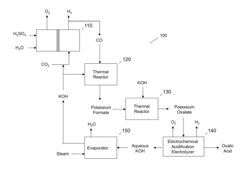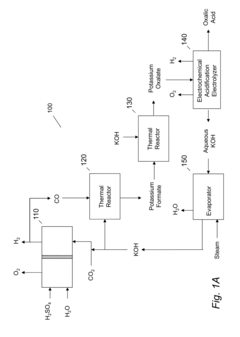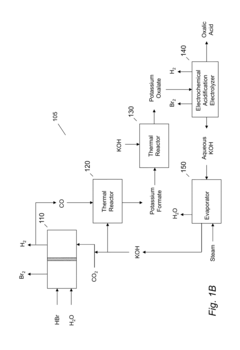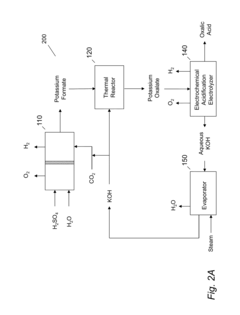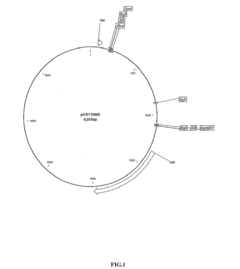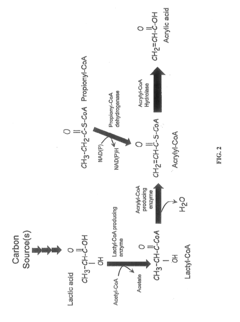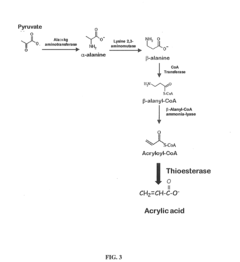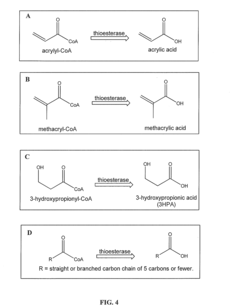Carboxylic Acid and Its Impact on Renewable Energy Technologies
JUL 31, 20259 MIN READ
Generate Your Research Report Instantly with AI Agent
Patsnap Eureka helps you evaluate technical feasibility & market potential.
Carboxylic Acid in Renewable Energy: Background and Objectives
Carboxylic acids have emerged as a crucial component in the development of renewable energy technologies, playing a significant role in the transition towards sustainable energy sources. The study of these organic compounds has gained momentum in recent years due to their versatile applications and potential to address key challenges in the renewable energy sector.
The primary objective of this research is to explore the multifaceted impact of carboxylic acids on various renewable energy technologies. This investigation aims to uncover novel applications, enhance existing processes, and contribute to the overall efficiency and sustainability of renewable energy systems.
Historically, carboxylic acids have been utilized in diverse industrial processes, including the production of polymers, pharmaceuticals, and food additives. However, their potential in the renewable energy sector has only recently come to the forefront of scientific inquiry. The growing interest in these compounds stems from their unique chemical properties, such as their ability to form hydrogen bonds and participate in esterification reactions.
In the context of renewable energy, carboxylic acids have shown promise in several key areas. They have been explored as potential biofuels, with certain long-chain fatty acids serving as precursors for biodiesel production. Additionally, carboxylic acids have demonstrated utility in energy storage systems, particularly in the development of advanced battery technologies and thermal energy storage materials.
The evolution of carboxylic acid research in renewable energy has been marked by significant technological advancements. Early studies focused primarily on the use of these compounds in biofuel production. However, recent years have seen a broadening of research scope, encompassing areas such as solar energy harvesting, fuel cells, and carbon capture technologies.
One of the most promising avenues of research involves the use of carboxylic acids in the production of sustainable materials for renewable energy applications. For instance, the development of bio-based polymers derived from carboxylic acids has opened up new possibilities for creating environmentally friendly components for solar panels and wind turbines.
As we delve deeper into the potential of carboxylic acids in renewable energy, it is crucial to consider the challenges and opportunities that lie ahead. These include improving the efficiency of carboxylic acid-based processes, reducing production costs, and addressing any potential environmental impacts associated with their large-scale use in energy applications.
The primary objective of this research is to explore the multifaceted impact of carboxylic acids on various renewable energy technologies. This investigation aims to uncover novel applications, enhance existing processes, and contribute to the overall efficiency and sustainability of renewable energy systems.
Historically, carboxylic acids have been utilized in diverse industrial processes, including the production of polymers, pharmaceuticals, and food additives. However, their potential in the renewable energy sector has only recently come to the forefront of scientific inquiry. The growing interest in these compounds stems from their unique chemical properties, such as their ability to form hydrogen bonds and participate in esterification reactions.
In the context of renewable energy, carboxylic acids have shown promise in several key areas. They have been explored as potential biofuels, with certain long-chain fatty acids serving as precursors for biodiesel production. Additionally, carboxylic acids have demonstrated utility in energy storage systems, particularly in the development of advanced battery technologies and thermal energy storage materials.
The evolution of carboxylic acid research in renewable energy has been marked by significant technological advancements. Early studies focused primarily on the use of these compounds in biofuel production. However, recent years have seen a broadening of research scope, encompassing areas such as solar energy harvesting, fuel cells, and carbon capture technologies.
One of the most promising avenues of research involves the use of carboxylic acids in the production of sustainable materials for renewable energy applications. For instance, the development of bio-based polymers derived from carboxylic acids has opened up new possibilities for creating environmentally friendly components for solar panels and wind turbines.
As we delve deeper into the potential of carboxylic acids in renewable energy, it is crucial to consider the challenges and opportunities that lie ahead. These include improving the efficiency of carboxylic acid-based processes, reducing production costs, and addressing any potential environmental impacts associated with their large-scale use in energy applications.
Market Analysis for Carboxylic Acid in Green Energy
The market for carboxylic acids in the renewable energy sector is experiencing significant growth, driven by the increasing demand for sustainable and eco-friendly energy solutions. Carboxylic acids play a crucial role in various green energy applications, particularly in the production of biofuels and energy storage systems.
In the biofuel industry, carboxylic acids serve as key intermediates in the conversion of biomass to renewable fuels. The global biofuel market is projected to expand rapidly, with a compound annual growth rate (CAGR) exceeding 7% over the next five years. This growth is primarily attributed to government mandates for blending biofuels with conventional fuels and the rising awareness of environmental sustainability.
The energy storage sector, particularly in the development of advanced batteries, represents another significant market for carboxylic acids. As the world transitions towards renewable energy sources, the demand for efficient energy storage solutions is escalating. Carboxylic acid-based electrolytes are being explored for their potential to enhance the performance and longevity of lithium-ion batteries, which are critical for both electric vehicles and grid-scale energy storage.
The market for carboxylic acids in green hydrogen production is also gaining traction. Carboxylic acids are being investigated as potential catalysts in the electrolysis process, which could lead to more efficient and cost-effective hydrogen production. With the global green hydrogen market expected to grow at a CAGR of over 50% in the coming years, this represents a significant opportunity for carboxylic acid applications.
Geographically, North America and Europe are currently the leading markets for carboxylic acids in renewable energy technologies. However, the Asia-Pacific region is expected to witness the fastest growth, driven by rapid industrialization, increasing energy demand, and supportive government policies promoting clean energy adoption.
Key players in the carboxylic acid market for renewable energy applications include major chemical companies and specialized renewable energy firms. These companies are investing heavily in research and development to improve the efficiency and cost-effectiveness of carboxylic acid-based solutions for green energy applications.
Despite the promising outlook, the market faces challenges such as high production costs and the need for technological advancements to improve the scalability of carboxylic acid applications in renewable energy. However, ongoing research and development efforts are expected to address these challenges, further driving market growth in the coming years.
In the biofuel industry, carboxylic acids serve as key intermediates in the conversion of biomass to renewable fuels. The global biofuel market is projected to expand rapidly, with a compound annual growth rate (CAGR) exceeding 7% over the next five years. This growth is primarily attributed to government mandates for blending biofuels with conventional fuels and the rising awareness of environmental sustainability.
The energy storage sector, particularly in the development of advanced batteries, represents another significant market for carboxylic acids. As the world transitions towards renewable energy sources, the demand for efficient energy storage solutions is escalating. Carboxylic acid-based electrolytes are being explored for their potential to enhance the performance and longevity of lithium-ion batteries, which are critical for both electric vehicles and grid-scale energy storage.
The market for carboxylic acids in green hydrogen production is also gaining traction. Carboxylic acids are being investigated as potential catalysts in the electrolysis process, which could lead to more efficient and cost-effective hydrogen production. With the global green hydrogen market expected to grow at a CAGR of over 50% in the coming years, this represents a significant opportunity for carboxylic acid applications.
Geographically, North America and Europe are currently the leading markets for carboxylic acids in renewable energy technologies. However, the Asia-Pacific region is expected to witness the fastest growth, driven by rapid industrialization, increasing energy demand, and supportive government policies promoting clean energy adoption.
Key players in the carboxylic acid market for renewable energy applications include major chemical companies and specialized renewable energy firms. These companies are investing heavily in research and development to improve the efficiency and cost-effectiveness of carboxylic acid-based solutions for green energy applications.
Despite the promising outlook, the market faces challenges such as high production costs and the need for technological advancements to improve the scalability of carboxylic acid applications in renewable energy. However, ongoing research and development efforts are expected to address these challenges, further driving market growth in the coming years.
Current Challenges in Carboxylic Acid Utilization
The utilization of carboxylic acids in renewable energy technologies faces several significant challenges that hinder their widespread adoption and efficiency. One of the primary obstacles is the high energy input required for the production and processing of carboxylic acids. This energy-intensive nature often offsets the potential environmental benefits, making it difficult to achieve a net positive impact on sustainability goals.
Another major challenge lies in the corrosive properties of carboxylic acids. Their acidic nature can lead to accelerated degradation of equipment and infrastructure, necessitating the use of specialized, costly materials in storage and processing facilities. This corrosion issue not only increases operational expenses but also raises safety concerns in industrial settings.
The volatility of carboxylic acids presents additional complications in their handling and storage. Many carboxylic acids have low boiling points, making them prone to evaporation and loss during processing. This volatility not only reduces overall efficiency but also poses potential environmental and health risks due to emissions.
Furthermore, the purification of carboxylic acids from renewable sources remains a complex and costly process. Biomass-derived carboxylic acids often contain impurities that can interfere with subsequent reactions or applications. Developing efficient and economical purification methods is crucial for enhancing the viability of carboxylic acids in renewable energy technologies.
The limited scalability of current production methods for renewable carboxylic acids is another significant hurdle. Many processes that work well in laboratory settings face challenges when scaled up to industrial levels, often due to decreased efficiency or increased costs. This scalability issue hampers the widespread implementation of carboxylic acid-based renewable energy solutions.
Additionally, the variability in feedstock quality and composition poses challenges in maintaining consistent product quality. Renewable sources of carboxylic acids, such as biomass, can vary significantly based on factors like growing conditions and seasonal changes. This variability complicates process control and product standardization, which are crucial for industrial applications.
Lastly, the competition from well-established petrochemical-based processes presents a significant market challenge. Many industries have long-standing infrastructure and processes optimized for petroleum-derived carboxylic acids. Overcoming this inertia and convincing stakeholders to transition to renewable alternatives requires not only technological advancements but also economic incentives and policy support.
Another major challenge lies in the corrosive properties of carboxylic acids. Their acidic nature can lead to accelerated degradation of equipment and infrastructure, necessitating the use of specialized, costly materials in storage and processing facilities. This corrosion issue not only increases operational expenses but also raises safety concerns in industrial settings.
The volatility of carboxylic acids presents additional complications in their handling and storage. Many carboxylic acids have low boiling points, making them prone to evaporation and loss during processing. This volatility not only reduces overall efficiency but also poses potential environmental and health risks due to emissions.
Furthermore, the purification of carboxylic acids from renewable sources remains a complex and costly process. Biomass-derived carboxylic acids often contain impurities that can interfere with subsequent reactions or applications. Developing efficient and economical purification methods is crucial for enhancing the viability of carboxylic acids in renewable energy technologies.
The limited scalability of current production methods for renewable carboxylic acids is another significant hurdle. Many processes that work well in laboratory settings face challenges when scaled up to industrial levels, often due to decreased efficiency or increased costs. This scalability issue hampers the widespread implementation of carboxylic acid-based renewable energy solutions.
Additionally, the variability in feedstock quality and composition poses challenges in maintaining consistent product quality. Renewable sources of carboxylic acids, such as biomass, can vary significantly based on factors like growing conditions and seasonal changes. This variability complicates process control and product standardization, which are crucial for industrial applications.
Lastly, the competition from well-established petrochemical-based processes presents a significant market challenge. Many industries have long-standing infrastructure and processes optimized for petroleum-derived carboxylic acids. Overcoming this inertia and convincing stakeholders to transition to renewable alternatives requires not only technological advancements but also economic incentives and policy support.
Existing Applications in Renewable Energy Sector
01 Synthesis of carboxylic acids
Various methods for synthesizing carboxylic acids are described, including oxidation of primary alcohols or aldehydes, hydrolysis of nitriles, and carbonylation reactions. These processes often involve catalysts and specific reaction conditions to achieve high yields and selectivity.- Synthesis of carboxylic acids: Various methods for synthesizing carboxylic acids are described, including oxidation of primary alcohols or aldehydes, hydrolysis of nitriles, and carbonylation reactions. These processes often involve catalysts and specific reaction conditions to achieve high yields and selectivity.
- Carboxylic acid derivatives and applications: Carboxylic acids can be converted into various derivatives such as esters, amides, and anhydrides. These derivatives have wide-ranging applications in industries including pharmaceuticals, polymers, and fine chemicals. The synthesis and use of these derivatives are explored in several patents.
- Purification and separation of carboxylic acids: Methods for purifying and separating carboxylic acids from reaction mixtures or natural sources are described. These include techniques such as crystallization, distillation, extraction, and chromatography. The focus is on improving purity and yield while reducing energy consumption and waste generation.
- Carboxylic acids in polymer chemistry: Carboxylic acids play a crucial role in polymer chemistry, serving as monomers or modifiers in various polymerization processes. Patents describe the use of carboxylic acids in the production of polyesters, polyamides, and other functional polymers with specific properties for diverse applications.
- Green chemistry approaches for carboxylic acids: Environmentally friendly methods for producing and using carboxylic acids are explored. These include bio-based production routes, catalytic processes with reduced waste, and the use of renewable feedstocks. The focus is on developing sustainable alternatives to traditional petrochemical-based processes.
02 Carboxylic acid derivatives and applications
Carboxylic acids can be converted into various derivatives such as esters, amides, and anhydrides. These derivatives have wide-ranging applications in industries including pharmaceuticals, polymers, and fine chemicals. The synthesis and use of these derivatives are explored in several patents.Expand Specific Solutions03 Purification and separation of carboxylic acids
Methods for purifying and separating carboxylic acids from reaction mixtures or natural sources are described. These techniques may include crystallization, distillation, extraction, and chromatography. Improving the purity and yield of carboxylic acids is crucial for their industrial applications.Expand Specific Solutions04 Carboxylic acids in polymer chemistry
Carboxylic acids play a significant role in polymer chemistry, serving as monomers or modifiers in various polymerization processes. They can be used to introduce functional groups, improve adhesion properties, or modify the physical characteristics of polymers.Expand Specific Solutions05 Environmental and green chemistry applications
Research on environmentally friendly processes for carboxylic acid production and utilization is ongoing. This includes the development of bio-based carboxylic acids, green catalysts for their synthesis, and sustainable applications in various industries to reduce environmental impact.Expand Specific Solutions
Key Industry Players in Carboxylic Acid Research
The research on carboxylic acid and its impact on renewable energy technologies is in a dynamic phase, with growing market potential and increasing technological maturity. The industry is transitioning from early-stage research to more advanced applications, driven by the global push for sustainable energy solutions. Key players like Chevron Phillips Chemical, Wacker Chemie, and DuPont are investing heavily in R&D, while research institutions such as Huaneng Clean Energy Research Institute and universities like Kunming University of Science & Technology are contributing to fundamental advancements. The market is characterized by a mix of established chemical companies and innovative startups, with collaborations between industry and academia accelerating progress. As the technology matures, we can expect to see more commercial applications and a potential market expansion in the coming years.
Dow Global Technologies LLC
Technical Solution: Dow Global Technologies LLC has developed innovative processes for converting carboxylic acids into renewable energy solutions. Their approach involves catalytic decarboxylation of fatty acids derived from biomass to produce renewable hydrocarbons[1]. This process can yield drop-in biofuels and biochemicals. They have also explored electrochemical reduction of carboxylic acids to produce value-added chemicals and fuels[2]. Additionally, Dow has invested in developing bio-based plastics using carboxylic acids as key intermediates, contributing to the circular economy and reducing reliance on fossil resources[3].
Strengths: Extensive R&D capabilities, diverse product portfolio, and strong market presence. Weaknesses: High capital costs for new technology implementation and potential regulatory challenges.
DuPont de Nemours, Inc.
Technical Solution: DuPont has made significant strides in utilizing carboxylic acids for renewable energy technologies. They have developed a bio-based process to produce 1,3-propanediol from renewable resources, which involves the fermentation of glucose to 3-hydroxypropionic acid, followed by its reduction[4]. This technology has applications in the production of bioplastics and biofuels. DuPont has also researched the use of carboxylic acids in advanced battery technologies, exploring their potential as electrolyte additives to enhance battery performance and longevity[5]. Furthermore, they have investigated the conversion of lignocellulosic biomass to carboxylic acids as a platform for renewable chemical production[6].
Strengths: Strong intellectual property portfolio and established partnerships in the bioeconomy. Weaknesses: Dependence on agricultural feedstocks and potential volatility in raw material prices.
Breakthrough Patents in Carboxylic Acid Technology
Integrated Process for Producing Carboxylic Acids from Carbon Dioxide
PatentActiveUS20130292257A1
Innovation
- An electrochemical system that reduces carbon dioxide to carboxylic acids and salts through an electrochemical cell, thermal reactor, and electrochemical acidification electrolyzer, utilizing an anolyte and catholyte feed with alkali metal hydroxide to produce oxalic acid, potentially using renewable energy sources.
Direct biocatalytic production of acrylic acid and other carboxylic acid compounds
PatentInactiveUS20140342414A1
Innovation
- Genetically manipulating microorganisms to produce acyl-CoA compounds and using heterologous polynucleotides encoding acyl-CoA hydrolases, such as thioesterases, to catalyze the hydrolysis of acyl-CoA to corresponding carboxylic acid compounds like acrylic acid, methacrylic acid, and 3-hydroxypropionic acid.
Environmental Impact Assessment
The environmental impact assessment of carboxylic acid in renewable energy technologies reveals both positive and negative implications. On the positive side, carboxylic acids play a crucial role in the development of sustainable energy solutions, particularly in biofuel production and energy storage systems. Their use in these applications can contribute to reducing greenhouse gas emissions and dependence on fossil fuels, thus mitigating climate change impacts.
In biofuel production, carboxylic acids serve as intermediates in the conversion of biomass to renewable fuels. This process utilizes waste materials and non-food crops, reducing competition with food production and minimizing land-use changes. The resulting biofuels have a lower carbon footprint compared to conventional fossil fuels, offering a more environmentally friendly alternative for transportation and industrial applications.
However, the production and use of carboxylic acids in renewable energy technologies also present environmental challenges. The synthesis of these compounds often involves energy-intensive processes and may require the use of petrochemical feedstocks, potentially offsetting some of the environmental benefits. Additionally, the large-scale production of carboxylic acids can lead to increased water consumption and the generation of waste streams that require proper treatment and disposal.
The use of carboxylic acids in energy storage systems, such as flow batteries, presents both opportunities and risks. While these systems can enhance the integration of intermittent renewable energy sources into the grid, the production and disposal of large quantities of acidic electrolytes pose potential environmental hazards. Proper containment, handling, and recycling protocols are essential to prevent soil and water contamination.
Lifecycle assessments of carboxylic acid-based renewable energy technologies indicate that their overall environmental impact depends on factors such as production methods, feedstock sources, and end-of-life management. Optimizing these aspects can significantly improve the sustainability profile of these technologies. Research into bio-based production methods and closed-loop recycling systems shows promise in further reducing the environmental footprint of carboxylic acid applications in renewable energy.
As the renewable energy sector continues to evolve, ongoing monitoring and assessment of the environmental impacts of carboxylic acid use will be crucial. This includes evaluating long-term effects on ecosystems, biodiversity, and human health. Balancing the potential benefits of reduced carbon emissions with the localized environmental risks associated with production and use will be key to ensuring the sustainable development of carboxylic acid-based renewable energy technologies.
In biofuel production, carboxylic acids serve as intermediates in the conversion of biomass to renewable fuels. This process utilizes waste materials and non-food crops, reducing competition with food production and minimizing land-use changes. The resulting biofuels have a lower carbon footprint compared to conventional fossil fuels, offering a more environmentally friendly alternative for transportation and industrial applications.
However, the production and use of carboxylic acids in renewable energy technologies also present environmental challenges. The synthesis of these compounds often involves energy-intensive processes and may require the use of petrochemical feedstocks, potentially offsetting some of the environmental benefits. Additionally, the large-scale production of carboxylic acids can lead to increased water consumption and the generation of waste streams that require proper treatment and disposal.
The use of carboxylic acids in energy storage systems, such as flow batteries, presents both opportunities and risks. While these systems can enhance the integration of intermittent renewable energy sources into the grid, the production and disposal of large quantities of acidic electrolytes pose potential environmental hazards. Proper containment, handling, and recycling protocols are essential to prevent soil and water contamination.
Lifecycle assessments of carboxylic acid-based renewable energy technologies indicate that their overall environmental impact depends on factors such as production methods, feedstock sources, and end-of-life management. Optimizing these aspects can significantly improve the sustainability profile of these technologies. Research into bio-based production methods and closed-loop recycling systems shows promise in further reducing the environmental footprint of carboxylic acid applications in renewable energy.
As the renewable energy sector continues to evolve, ongoing monitoring and assessment of the environmental impacts of carboxylic acid use will be crucial. This includes evaluating long-term effects on ecosystems, biodiversity, and human health. Balancing the potential benefits of reduced carbon emissions with the localized environmental risks associated with production and use will be key to ensuring the sustainable development of carboxylic acid-based renewable energy technologies.
Regulatory Framework for Carboxylic Acid in Energy
The regulatory framework for carboxylic acid in the energy sector is a complex and evolving landscape that significantly impacts the development and implementation of renewable energy technologies. As carboxylic acids play an increasingly important role in various energy applications, governments and regulatory bodies worldwide have been working to establish comprehensive guidelines and standards to ensure their safe and efficient use.
In the United States, the Environmental Protection Agency (EPA) has taken a leading role in regulating carboxylic acids in energy applications. The agency has implemented stringent guidelines for the production, handling, and disposal of these compounds, particularly in the context of biofuel production. The Renewable Fuel Standard (RFS) program, administered by the EPA, includes specific provisions for carboxylic acid-based biofuels, outlining requirements for greenhouse gas emission reductions and sustainability criteria.
The European Union has also developed a robust regulatory framework for carboxylic acids in the energy sector. The Registration, Evaluation, Authorization, and Restriction of Chemicals (REACH) regulation governs the use of carboxylic acids in various applications, including renewable energy technologies. Additionally, the Renewable Energy Directive (RED II) sets targets for renewable energy consumption and includes sustainability criteria for biofuels, which often involve carboxylic acid intermediates.
In Asia, countries like China and Japan have been actively developing their regulatory frameworks to address the growing use of carboxylic acids in energy applications. China's Ministry of Ecology and Environment has implemented strict environmental protection laws that cover the production and use of carboxylic acids in renewable energy technologies. Japan's Ministry of Economy, Trade, and Industry has established guidelines for the safe handling and transportation of carboxylic acids used in energy production.
International organizations, such as the International Energy Agency (IEA) and the United Nations Framework Convention on Climate Change (UNFCCC), have also played crucial roles in shaping global regulatory frameworks for carboxylic acids in energy. These organizations provide recommendations and best practices for member countries to adopt in their national regulations.
As research on carboxylic acids and their impact on renewable energy technologies continues to advance, regulatory frameworks are expected to evolve accordingly. Future regulations are likely to focus on optimizing the balance between promoting innovation in renewable energy technologies and ensuring environmental and safety standards are met. This may include the development of more specific guidelines for emerging applications of carboxylic acids in energy storage, carbon capture, and advanced biofuel production.
In the United States, the Environmental Protection Agency (EPA) has taken a leading role in regulating carboxylic acids in energy applications. The agency has implemented stringent guidelines for the production, handling, and disposal of these compounds, particularly in the context of biofuel production. The Renewable Fuel Standard (RFS) program, administered by the EPA, includes specific provisions for carboxylic acid-based biofuels, outlining requirements for greenhouse gas emission reductions and sustainability criteria.
The European Union has also developed a robust regulatory framework for carboxylic acids in the energy sector. The Registration, Evaluation, Authorization, and Restriction of Chemicals (REACH) regulation governs the use of carboxylic acids in various applications, including renewable energy technologies. Additionally, the Renewable Energy Directive (RED II) sets targets for renewable energy consumption and includes sustainability criteria for biofuels, which often involve carboxylic acid intermediates.
In Asia, countries like China and Japan have been actively developing their regulatory frameworks to address the growing use of carboxylic acids in energy applications. China's Ministry of Ecology and Environment has implemented strict environmental protection laws that cover the production and use of carboxylic acids in renewable energy technologies. Japan's Ministry of Economy, Trade, and Industry has established guidelines for the safe handling and transportation of carboxylic acids used in energy production.
International organizations, such as the International Energy Agency (IEA) and the United Nations Framework Convention on Climate Change (UNFCCC), have also played crucial roles in shaping global regulatory frameworks for carboxylic acids in energy. These organizations provide recommendations and best practices for member countries to adopt in their national regulations.
As research on carboxylic acids and their impact on renewable energy technologies continues to advance, regulatory frameworks are expected to evolve accordingly. Future regulations are likely to focus on optimizing the balance between promoting innovation in renewable energy technologies and ensuring environmental and safety standards are met. This may include the development of more specific guidelines for emerging applications of carboxylic acids in energy storage, carbon capture, and advanced biofuel production.
Unlock deeper insights with Patsnap Eureka Quick Research — get a full tech report to explore trends and direct your research. Try now!
Generate Your Research Report Instantly with AI Agent
Supercharge your innovation with Patsnap Eureka AI Agent Platform!
